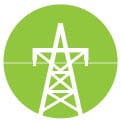2018 transmission-outage coordination stats and goals
 ISO-NE had requests for almost 3,500 planned outages and handled over 800 unplanned outages last year
ISO-NE had requests for almost 3,500 planned outages and handled over 800 unplanned outages last year
No one wants a power line to stop working unexpectedly, like during a major storm. But power lines and other transmission equipment must undergo some down time so that participating transmission owners (PTOs) can conduct routine maintenance for avoiding emergencies, accommodate new construction, or address problems that crop up. One of the ISO’s responsibilities is to analyze impacts of and schedule these outages all over New England with the PTOs and local control centers (LCCs) so that the PTOs do not remove their equipment from service at the same time or when an outage will negatively affect some other ongoing activity. The long-term scheduling of transmission outages is critical because it gives the ISO the time to measure both the reliability and economic impacts of proposed outages to the system and communicate the probable effects to market participants, which helps keep the energy markets operating efficiently.
The ISO New England Transmission Equipment Outage Coordination 2018 report summarizes the outage process that took place in 2018, the number and types of outages that occurred, and the 2019 goals for the ISO’s Outage-Coordination group for improving outage coordination, reducing congestion costs, and increasing operational flexibility.
Types of transmission equipment outages
The outage-coordination process classifies transmission equipment outages as follows:
- Planned—taking equipment out of service to conduct routine maintenance or to accommodate new construction, with the request for the outage submitted at least 21 days in advance
- Unplanned—when equipment is forced out of service because a problem was discovered and the request for the outage did not meet the minimum notification requirements of the planned outage identified in OP 3. Unplanned outages can be emergency outages or forced outages:
- An emergency outage is the obvious failure of a piece of transmission equipment that comes out of service on its own or requires immediate operator intervention to remove it from service.
- A forced outage is the discovery of a problem that needs to be repaired as soon as any combination of crews, equipment, or corrective dispatch actions can be put in place to allow the work to be performed. By definition, a forced outage cannot be scheduled.
- Opportunity—when unanticipated changes on the power system allow transmission work to take place that otherwise would have required outage scheduling at a less opportune time
- Cancelled—a requested outage ultimately not taken
The duration of an outage can vary from a few minutes to several weeks or months, and it can be continuous or noncontinuous. Because of the urgency of forced and emergency transmission-outage requests, they receive a higher scheduling priority than those for planned equipment outages.
Outage-request stats for 2018
In 2018, the ISO had requests for almost 3,500 planned outages and handled over 800 unplanned outages. Of all the outage requests the ISO processed in 2018, 80.8% were scheduled and taken as planned outages, and 19.2% were taken as unplanned outages, which is a decline of approximately 2.5% from 2017.
Outage-coordination goals for 2019
The ISO continuously works with PTOs and LCCs to improve the timely submittal and coordination of planned outages and reduce the number of unplanned transmission equipment outages. The ISO’s Outage-Coordination team has set several targets for 2019:
- At least 60% of all transmission equipment outage requests will be submitted more than 90 days before the planned outage date.
- At least 80% of all transmission-outage requests in 2019 will be submitted via the long-term process.
- At least 85% of all outages will be planned outages.
- The annual average of all cancellations submitted before 10:00 a.m. the day before a scheduled outage will be at least 65%.
- At least 98% of the requests for outages of transmission lines >200 kilovolts for a duration more than five days will be submitted at least 30 days before the scheduled outage date, excluding all unplanned outage requests.
Governing documents
The outage-coordination report serves as compliance with certain provisions of the Transmission Operating Agreements (TOAs) the ISO has with each PTO. The TOAs define the ISO’s authority to direct regional transmission facility operations and, among other provisions, annually assess transmission equipment outage coordination, the long-term impacts of the ISO’s rescheduling of transmission-outage requests, and the accuracy of transmission congestion cost estimates. Other documents governing the ISO’s transmission-outage coordination include Market Rule 1, which sets forth the scheduling, other procedures, and certain general provisions applicable to the operation of New England’s wholesale energy markets; the Federal Energy Regulatory Commission’s Order No. 2000; regional and national reliability standards; and ISO operating documents.
Find out more about the ISO’s transmission-outage scheduling.
- Categories
- Industry News & Developments
- Tags
- system operations, transmission planning



